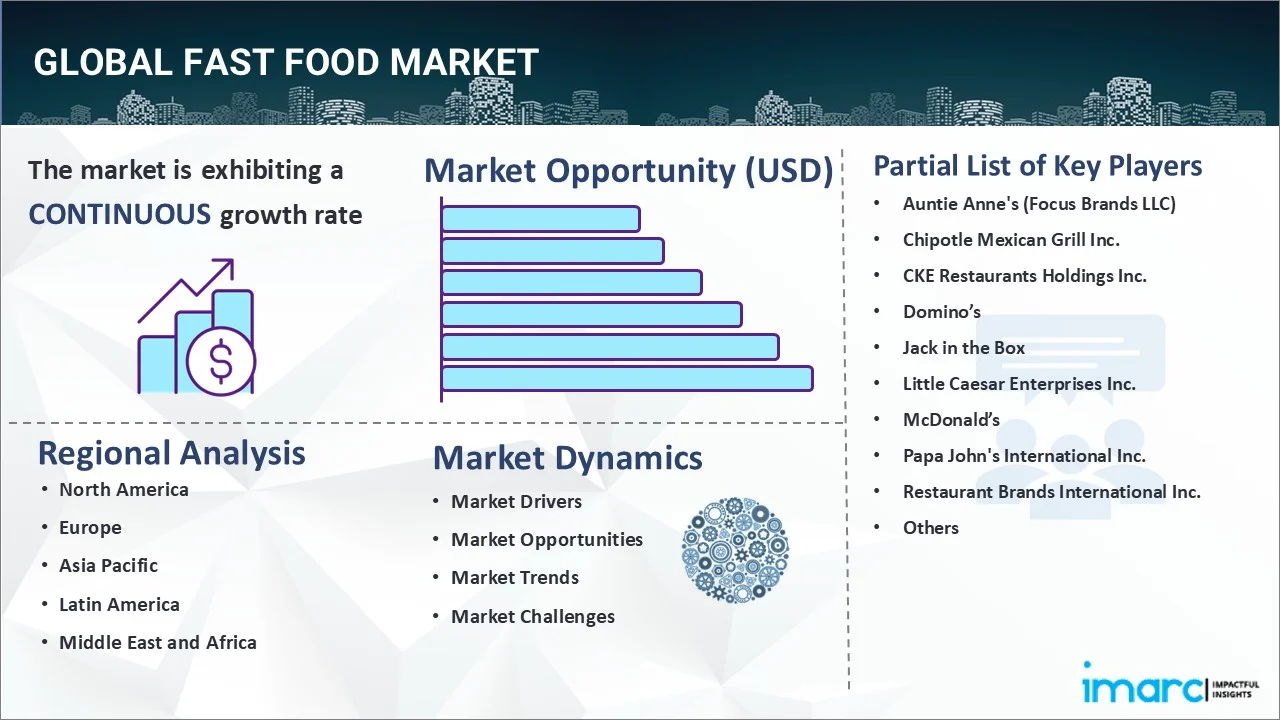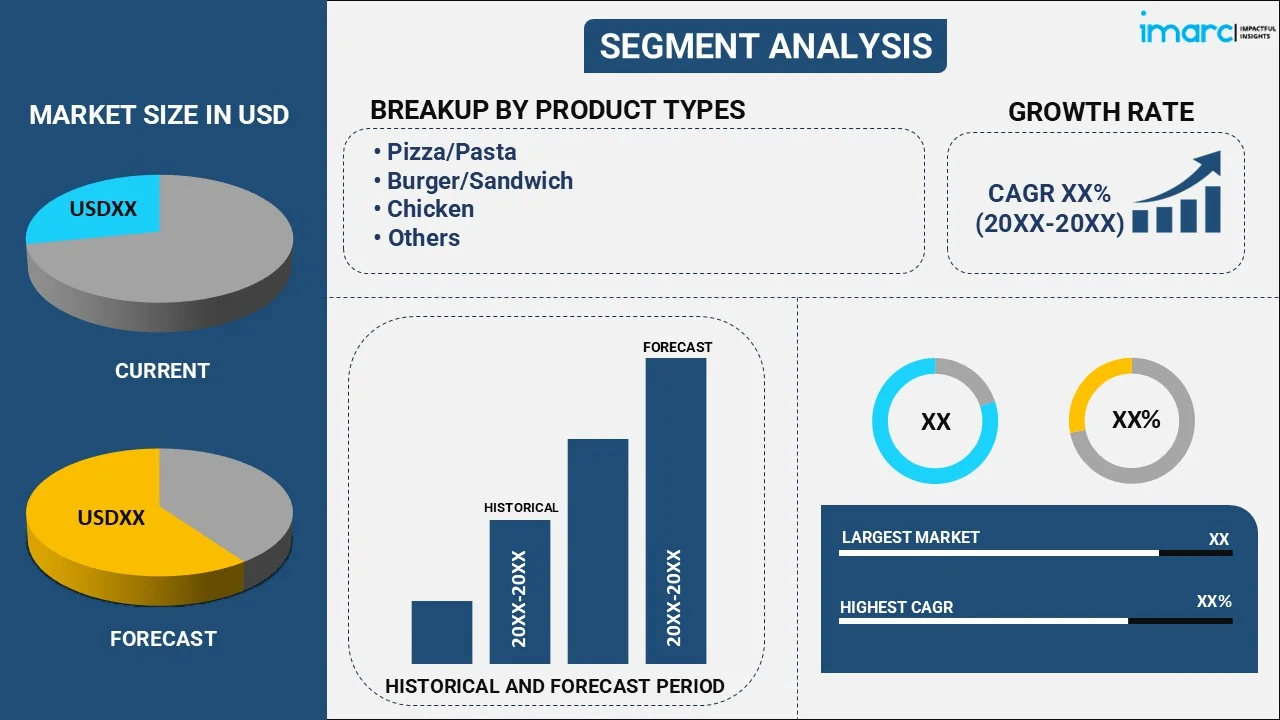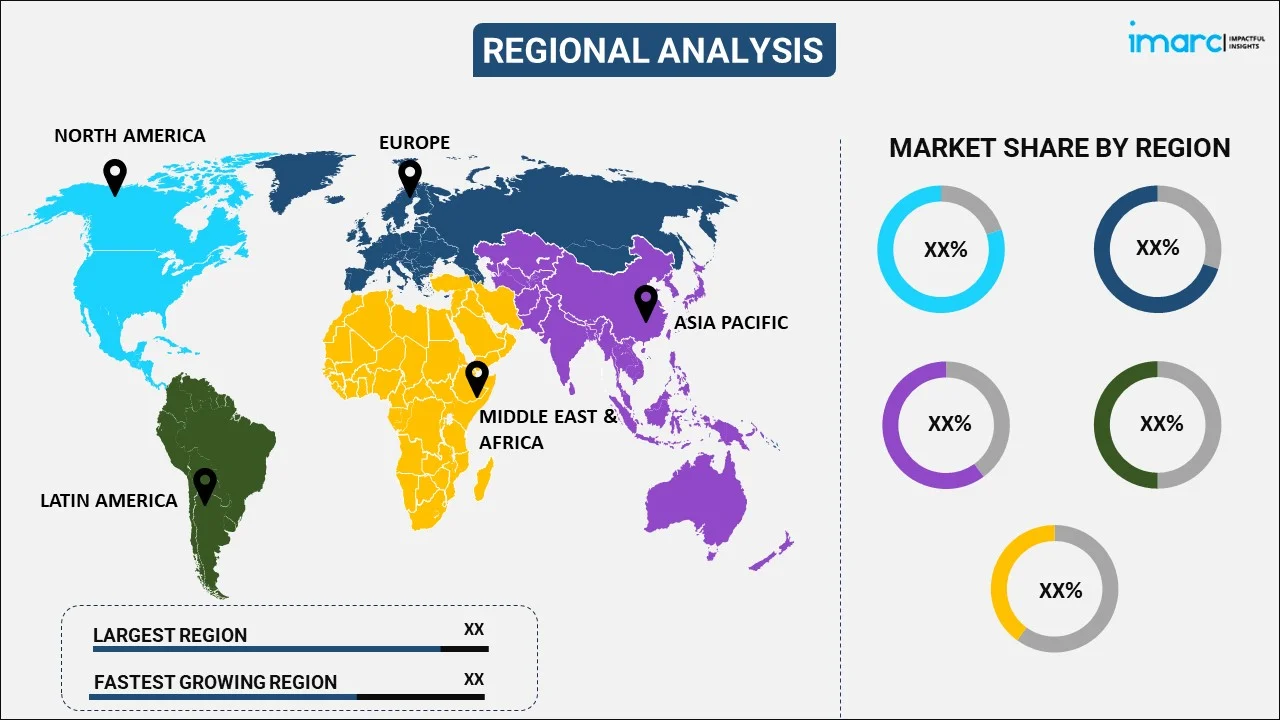
Fast Food Market Report by Product Type (Pizza/Pasta, Burger/Sandwich, Chicken, Asian/Latin American Food, Seafood, and Others), End User (Food-Service Restaurants, Quick Service Restaurants, Caterings, and Others), and Region 2025-2033
Market Overview:
The global fast food market size reached USD 902.1 Billion in 2024. Looking forward, the market is expected to reach USD 1,298.5 Billion by 2033, exhibiting a growth rate (CAGR) of 4.09% during 2025-2033. North America dominated the market in 2024. The increasing consumer preference for RTE food products, the rising number of commercial establishments, and the growing adoption of fast food like frozen ready meals in the food service industry are some of the major factors propelling the market.
|
Report Attribute
|
Key Statistics
|
|---|---|
|
Base Year
|
2024
|
|
Forecast Years
|
2025-2033
|
|
Historical Years
|
2019-2024
|
|
Market Size in 2024
|
USD 902.1 Billion |
|
Market Forecast in 2033
|
USD 1,298.5 Billion |
| Market Growth Rate 2025-2033 | 4.09% |
Fast Food Market Analysis:
- Major Market Drivers: The global fast food market is driven by a confluence of factors that propels its market growth and its appeal across the world. The demand for convenience is mainly driven by fast-paced lifestyles and rise in urbanization, which is resulting in consumers seeking quick and easy meal solutions. Affordable prices and widespread availability of fast food outlets contribute significantly to its market growth. Technological advancements like digital ordering systems, mobile applications and efficient delivery services which further enhance consumer experiences and operational efficiencies is contribution to positive outlook for the market. Furthermore, the expansion of menu options in order to include healthier and more diverse food choices serving to the evolving consumer preferences thereby propelling fast food market growth.
- Key Market Trends: The global fast food market is witnessing a several key trends that are influencing its market growth and its evolution. A major trend is the rise in consumer preferences for healthier, high quality food options that leads to an increase in food offerings like salads, wraps and vegetarian meals. The widespread adoption of digital technology is also a significant trend in fast food market, as mobile ordering, self-service kiosks and artificial intelligence (AI)-driven customer service enhancements are becoming a more conventional. In line with this, the growing shift towards sustainability with chains adopting eco-friendly practices like biodegradable packaging and sourcing locally grown ingredients is also driving fast food market growth.
- Geographical Trends: Geographically, the fast food market is experiencing a significant growth and transformation across various regions. North America continues to dominate the fast food market mainly due to its robust fast food culture and also the high consumer spending power. Europe is also a strong market mainly characterized by rising consumer preference for fast food options which offers a healthier alternatives and sustainable practices. Meanwhile in the Asia Pacific region rapid fast food market growth is mainly fueled by increase in urbanization, rising disposable incomes and the growing adoption of western eating habits mainly among younger population. Countries like China and India are key drivers in Asia-Pacific region mainly because of their large population and increase in demand for convenience and quick service restaurants.
- Competitive Landscape: Some of the major market players in the keyword industry include Auntie Anne's (Focus Brands LLC), Chipotle Mexican Grill Inc., CKE Restaurants Holdings Inc., Domino's, Jack in the Box, Little Caesar Enterprises Inc., McDonald's, Papa John's International Inc., Restaurant Brands International Inc., Subway, The Wendy's Company, Yum! Brands Inc among many others.
- Challenges and Opportunities: The global fast food market witnesses several challenges and opportunities. One of the major challenges in fast food market is rise in health consciousness among consumers that further pressures the chains to adapt to healthier menu options which can be a bit costly to develop. Regulatory concerns over environmental impacts and nutritional disclosures also create significant challenges in fast food market growth. Moreover, the market saturation in many regions leads to the intense competition. However, on the opportunity side, fast food companies are incorporating various technologies for streamlined operations and enhanced consumer experiences from mobile ordering to AI driven service enhancement. Furthermore, the growing trend toward personalized and culturally diverse menu offerings presence avenues for fast food market growth.

Fast Food Market Trends/Drivers:
Increasing change in lifestyle patterns
Modern lifestyles often involve busy schedules and less time for home-cooked meals. Fast food caters to this shift by providing quick, convenient options that fit into active routines. According to a study by the National Centre for Health Statistics (NCHS), between 2013 and 2016, 36.6% of adults consumed fast food on a given day. Younger adults showed higher consumption rates, i.e., 44.9% for those aged 20–39, 37.7% for those aged 40–59, and 24.1% for those 60 and over. Fast food industry growth statistics reinforce this pattern, highlighting increased demand driven by speed, accessibility, and evolving consumer habits. Whether it's families needing quick dinners or professionals eating on the go, the industry’s ability to align with changing lifestyles continues to support its rapid expansion.
Rise in affordability
Fast food is often seen as a cost-effective option, especially when compared to dining in more traditional restaurants. According to a study conducted by the National Centre for Health Statistics (NCHS), approximately 31.7% of lower-income, 36.4% of middle-income, and 42% of higher-income adults ate fast food on a given day. This trend was observed for both men and women. There was no significant difference between men and women in the percentage of fast food consumption within each income level. Fast food industry statistics like these underline the broad appeal across income groups. The competitive pricing and wide variety of budget-friendly menu items make fast food a popular choice for many, particularly among students and working-class individuals. This affordability factor continues to drive demand as people seek to maximize value without sacrificing taste or quality.
Growing influence of marketing and branding
The influence of marketing and branding is a significant factor driving the growth of the fast food industry. Fast food chains have used creative partnerships and digital incentives to capture attention and boost engagement. For instance, Chipotle teamed up with TEKKEN 8, offering in-game currency for digital orders, launching a themed Battle Bowl, and sponsoring the 2024 Chipotle Challenger Series. These promotions are tailored for the Fighting Game Community and showcase how immersive marketing can drive traffic. Advertising across multimedia platforms allows brands to target varied demographics, reinforcing loyalty and repeat business. This brand-led growth strategy has helped solidify market dominance for key players. Fast food market share by brand reflects this trend, where companies with strong marketing campaigns consistently outperform competitors. Strategic branding and cross-platform outreach continue to shape consumer behavior and expand market share across the fast food segment.
Fast Food Industry Segmentation:
IMARC Group provides an analysis of the key trends in each segment of the global fast food market report, along with forecasts at the global, regional and country levels from 2025-2033. Our report has categorized the market based on product type and end user.
Breakup by Product Type:

- Pizza/Pasta
- Burger/Sandwich
- Chicken
- Asian/Latin American Food
- Seafood
- Others
Burger/sandwich dominates the market
The report has provided a detailed breakup and analysis of the market based on the product type. This includes pizza/pasta, burger/sandwich, chicken, Asian/Latin American food, seafood, and others. According to the report, burger/sandwich represented the largest segment. It features items made with buns or bread slices, enclosing fillings such as beef, chicken, fish, or vegetarian options. These offerings often come with a variety of toppings, sauces, and sides. The appeal of the burger/sandwich lies in its ease of holding while consuming and the ability to assemble and serve quickly.
Chicken-based fast food includes fried, grilled, or roasted chicken pieces and meals. These items are often served with sides like fries, coleslaw, and biscuits. Chicken fast food outlets are known for their flavorful and crispy offerings, attracting people seeking a protein-centric meal.
Breakup by End User:
- Food-Service Restaurants
- Quick Service Restaurants
- Caterings
- Others
Quick service restaurants hold the largest share in the market
A detailed breakup and analysis of the market based on the end user has also been provided in the report. This includes food-service restaurants, quick service restaurants, caterings, and others. According to the report, quick service restaurants accounted for the largest market share. Fast food industry overview data shows that these establishments are designed to provide quick, efficient service to people who are looking for a speedy meal. These people are often individuals or families seeking a convenient and rapid dining option. QSRs usually have a focused menu with items like burgers, fries, chicken, and other easily prepared offerings.
Food service restaurants refer to establishments that offer fast food options alongside other types of dishes in a sit-down setting. These restaurants provide a range of menu items, often including burgers, sandwiches, pizzas, and more. End users of fast food within food service restaurants are typically individuals or groups looking for a casual dining experience with a variety of menu choices.
Catering services provide fast food options for larger groups or events. The end users of fast food in catering are event planners, businesses, or individuals organizing gatherings, meetings, parties, or conferences. Catering companies offer the convenience of bulk ordering and delivery, making it easy for hosts to provide a variety of fast-food items to satisfy the tastes of their attendees.
Breakup by Region:

- North America
- United States
- Canada
- Asia-Pacific
- China
- Japan
- India
- South Korea
- Australia
- Indonesia
- Others
- Europe
- Germany
- France
- United Kingdom
- Italy
- Spain
- Russia
- Others
- Latin America
- Brazil
- Mexico
- Others
- Middle East and Africa
North America exhibits a clear dominance, accounting for the largest fast food market share
The report has also provided a comprehensive analysis of all the major regional markets, which include North America (the United States and Canada); Asia Pacific (China, Japan, India, South Korea, Australia, Indonesia, and others); Europe (Germany, France, the United Kingdom, Italy, Spain, Russia, and others); Latin America (Brazil, Mexico, and others); and the Middle East and Africa. According to the report, North America accounted for the largest market share.
The establishment of commercial spaces like QSRs represents one of the primary factors driving the demand for fast food in the North American region. Moreover, the rising inclination towards franchise business models by restaurant chains is contributing to the market growth in the region. Besides this, the growing adoption of home delivery models is influencing the market positively in the region. For example, as per industry reports, in the US, McDonald's is the largest fast food chain by sales, followed by Starbucks due to global presence, strong branding, efficient operations, localized menus, strategic marketing, tech adoption like mobile apps, and prime real estate. These factors drive customer loyalty, high foot traffic, and consistent revenue growth worldwide.
Competitive Landscape:
The leading companies are developing mobile apps that allow customers to place orders, customize meals, and pay in advance, which reduces wait times, enables personalized orders, and encourages customer loyalty through rewards and promotions. They are also emerging self-service kiosks in fast food restaurants that enable customers to place their orders without interacting with a cashier, and enhance order accuracy, reduce lines, and provide an interactive and efficient ordering process. Moreover, product manufacturers are adopting the use of advanced payment methods, such as contactless payment options and QR code scanning, to minimize physical contact and enhance safety. Besides this, key players are utilizing data analytics to gather insights into customer preferences and behaviors to personalize menu recommendations, promotions, and marketing campaigns.
The report has provided a comprehensive analysis of the competitive landscape in the market. Detailed profiles of all major companies have also been provided. Some of the key players in the market include:
- Auntie Anne's (Focus Brands LLC)
- Chipotle Mexican Grill Inc.
- CKE Restaurants Holdings Inc.
- Domino's
- Jack in the Box
- Little Caesar Enterprises Inc.
- McDonald's
- Papa John's International Inc.
- Restaurant Brands International Inc.
- Subway
- The Wendy's Company
- Yum! Brands Inc.
(Please note that this is only a partial list of the key players, and the complete list is provided in the report.)
Fast Food Market Recent Developments:
- In 2024, Chipotle Mexican Grill opened its first restaurant in Kuwait in partnership with Alshaya Group, marking its first entry into a new country in over a decade. The restaurant features a new design format and offers various in-restaurant ordering experiences to introduce its menu to new guests in the region.
- In 2024, Papa John's International, Inc. is expanding its North American footprint by opening 50 new restaurants by 2028 in collaboration with franchisee Nadeem Bajwa and The Bajco Group. This strategic partnership aims to broaden Papa John's presence in existing markets and accelerate growth through initiatives like the Back to Growth Program.
- In 2021, McDonald’s global same-store sales jumped 40.5% in Q2, with US sales rising 25.5%. Growth was fueled by the Crispy Chicken Sandwich and a digital campaign featuring BTS. Executives credited delivery expansion, digital ordering, and focused marketing as core drivers. The BTS meal and renewed chicken sandwich ads stood out as top-performing efforts in lifting average customer spending and overall traffic.
Fast Food Market Report Scope:
| Report Features | Details |
|---|---|
| Base Year of the Analysis | 2024 |
| Historical Period | 2019-2024 |
| Forecast Period | 2025-2033 |
| Units | Billion USD |
| Scope of the Report | Exploration of Historical and Forecast Trends, Industry Catalysts and Challenges, Segment-Wise Historical and Predictive Market Assessment:
|
| Product Types Covered | Pizza/Pasta, Burger/Sandwich, Chicken, Asian/Latin American Food, Seafood, Others |
| End Users Covered | Food-Service Restaurants, Quick-Service Restaurants, Caterings, Others |
| Regions Covered | Asia Pacific, Europe, North America, Latin America, Middle East and Africa |
| Countries Covered | United States, Canada, Germany, France, United Kingdom, Italy, Spain, Russia, China, Japan, India, South Korea, Australia, Indonesia, Brazil, Mexico |
| Companies Covered | Auntie Anne's (Focus Brands LLC), Chipotle Mexican Grill Inc., CKE Restaurants Holdings Inc., Domino's, Jack in the Box, Little Caesar Enterprises Inc., McDonald's, Papa John's International Inc., Restaurant Brands International Inc., Subway, The Wendy's Company, Yum! Brands Inc., etc. |
| Customization Scope | 10% Free Customization |
| Post-Sale Analyst Support | 10-12 Weeks |
| Delivery Format | PDF and Excel through Email (We can also provide the editable version of the report in PPT/Word format on special request) |
Key Benefits for Stakeholders:
- IMARC’s report offers a comprehensive quantitative analysis of various market segments, historical and current market trends, market forecasts, and dynamics of the fast food market from 2019-2033.
- The research study provides the latest information on the market drivers, challenges, and opportunities in the global fast food market.
- The study maps the leading, as well as the fastest-growing, regional markets. It further enables stakeholders to identify the key country-level markets within each region.
- Porter's five forces analysis assist stakeholders in assessing the impact of new entrants, competitive rivalry, supplier power, buyer power, and the threat of substitution. It helps stakeholders to analyze the level of competition within the fast food industry and its attractiveness.
- Competitive landscape allows stakeholders to understand their competitive environment and provides an insight into the current positions of key players in the market.
Key Questions Answered in This Report
The global fast food market was valued at USD 902.1 Billion in 2024.
The fast food industry is expected to reach USD 1,298.5 Billion by 2033.
We expect the global fast food market to exhibit a CAGR of 4.09% during 2025-2033.
The emerging trend of food vlogging, along with the introduction of innovative and exotic recipes by service restaurants using natural, organic, and plant-based ingredients, is primarily driving the global fast food market.
The sudden outbreak of the COVID-19 pandemic has led to the changing consumer inclination from conventional brick-and-mortar distribution channels towards online retail platforms for the purchase of fast food.
Based on the product type, the global fast food market has been segregated into pizza/pasta, burger/sandwich, chicken, Asian/Latin American food, seafood, and others. Among these, burger/sandwich currently holds the largest market share.
Based on the end user, the global fast food market can be bifurcated into food-service restaurants, quick service restaurants, caterings, and others. Currently, quick service restaurants exhibit a clear dominance in the market.
On a regional level, the market has been classified into North America, Asia-Pacific, Europe, Latin America, and Middle East and Africa, where North America currently dominates the global market.
Some of the major players in the global fast food market include Auntie Anne's (Focus Brands LLC), Chipotle Mexican Grill Inc., CKE Restaurants Holdings Inc., Domino's, Jack in the Box, Little Caesar Enterprises Inc., McDonald's, Papa John's International Inc., Restaurant Brands International Inc., Subway, The Wendy's Company, Yum! Brands Inc., etc.
McDonald's is leading the fast food industry.
Need more help?
- Speak to our experienced analysts for insights on the current market scenarios.
- Include additional segments and countries to customize the report as per your requirement.
- Gain an unparalleled competitive advantage in your domain by understanding how to utilize the report and positively impacting your operations and revenue.
- For further assistance, please connect with our analysts.
 Request Customization
Request Customization
 Speak to an Analyst
Speak to an Analyst
 Request Brochure
Request Brochure
 Inquire Before Buying
Inquire Before Buying




.webp)




.webp)












